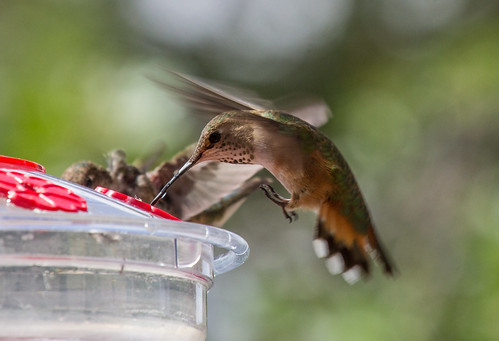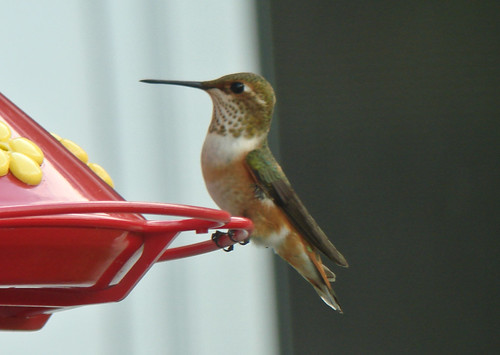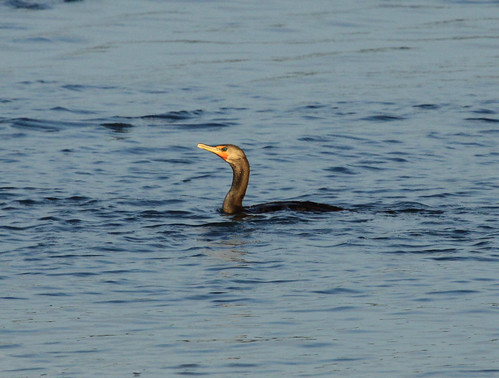In my blogpost about out-of-range hummingbirds, I quoted Scott Weidensaul, who noted that the out-of-range birds that appear in the East usually arrive here well after our Ruby-throats have disappeared for the season. That’s one of those rules that is virtually always true but has exceptions. For example, on August 11, 2007, I saw and photographed a Rufous or Allen’s Hummingbird at a feeder in northern Wisconsin. The homeowner noticed the little thing because it stood out by its aggressive behavior— even by hummingbird standards, it was exceptionally bellicose in chasing everyone from the feeder, a notable characteristic of Rufous Hummingbirds. They’re even tinier than Ruby-throats but more pugnacious—sort of the chihuahuas of the bird world.
On August 14 this year, Steve Patterson posted on Facebook’s KAXE-KBXE Season Watch a photo of a backlit hummingbird.
 |
| Photo copyright 2021 by Steve Patterson |
He took it for a Ruby-throat, though he wondered a bit because the bird’s throat was more speckled than most Ruby-throats. When I saw the photo, I immediately focused on the spread tail. The outer three feathers, like a Ruby-throated female’s, were tipped with white, with a darker section above that; the rest of the tail appeared quite orangey or rufous. Also, the bird’s sides looked browner over a more extensive area than most Ruby-throats’ do. I was certain that it was a Rufous or a very similar but even rarer possibility, an Allen’s. When I told Steve, he sent another photo he'd taken of the same bird. The sides didn't seem as rusty as I'd have expected, but my preconceived notion kept me from looking too carefully.
 | |
|
Steve, who generously and frequently contributes his photos and insights to that KAXE forum, gave me permission to share his photos on my blog. As I studied them, I suddenly realized my initial impression was wrong—the rufous color of the tail feathers was simply an artifact of the backlighting. When I started focusing on the central tail feathers, which lacked white tips (as they should for all three possibilities—Ruby-throat, Rufous, and Allen’s) I suddenly realized that those central tail feathers in Rufous and Allen’s are dark-tipped, which would have been clear in the photo despite the backlighting.
 |
| This real Rufous Hummingbird is in range, in New Mexico in July 2013. |
The fact that the rufous color extended all the way to the tips of those central tail feathers made it clear that rufous was not the true feather color. The bird really was what Steve originally thought, a Ruby-throat. Oops! I was wrong.
Again, during the peak of migration, just about every hummingbird we’re ever going to see in the Upper Midwest will be a Ruby-throat. Giving them more attention just in case is still warranted, and sharing our sightings of outliers is important. But when we post sightings of rarities on eBird, a valuable tool for researchers as well as list-keeping birders, we will always be asked for documentation, which virtually always requires clear photographs. With active birds such as hummingbirds, those photos can be essential for accurately identifying the birds in the first place.
If I’d seen but not photographed Steve’s bird in that lighting situation, I’d have submitted it as a Rufous or, more generically because of the even more remote chance of Allen’s, as a Selasphorus sp. Although eBird would have let me count it that way on my own private list, the sighting would probably have, quite rightfully, been rejected by the eBird reviewer for their scientific database despite my certainty that the bird had so much rufous coloring. Had I taken the photo and submitted that to eBird as a Rufous Hummingbird, the reviewer or a researcher down the line would have noticed the problem with the central tail feathers and, again, rejected the sighting.
We birders can’t help but be embarrassed, even mortified, when we make a mistake. Some birders at all levels think eBird's requests for documentation are personal attacks on their birding skills. But the whole point of identifying birds is to, well, identify them. Accuracy is essential in such a geeky hobby, isn’t it? Our lifelists and other birding lists are meaningless if we don’t have enough humility to clear out erroneous IDs when we realize an error or don’t have enough information to absolutely confirm a sighting isn’t something else. Rather than focusing on hurt pride, good birders learn from their mistakes. By admitting errors publicly, those of us who write field guides and lead field trips can help others avoid those same mistakes.
I’ll never forget when a Yellow-billed Loon was sighted along Brighton Beach in Duluth in October 1987. I heard about it while I was counting at the Lakewood Pumping Station, and was told it was working its way up the shore. This was in the days before cell phones and text messaging, and the original sighting was a good 45 minutes before I heard about it, so I decided to pull over everywhere I could as I worked my way toward the beach. Three or four other very experienced birders were also arriving when I pulled into my very first stop—our group included some of the top birders in the state. We scanned the water and almost instantly spotted the bird—that low-slung loon shape and what appeared to be a solid yellow bill, subtly upturned.
We were of course thrilled—this was only the second sighting ever of the species in Minnesota. We all got great spotting scope looks, and then something about it struck me, and I suddenly realized it wasn’t a loon at all, but an immature cormorant. Everyone looked again, and sure enough. And we all made it down to Brighton Beach where Kim Eckert still had a spotting scope pointed at the real Yellow-billed Loon.
It was embarrassing of course, but a good lesson about self-delusion when you are expecting to see a good bird. It was also a good lesson in how swimming cormorants do have a loon-like silhouette, and that the way cormorants hold their head slightly uptilted can be a little similar to how Red-throated and Yellow-billed Loon bills are slightly angled upward.
Even as I was figuring out how important this lesson would be in helping new birders with waterbird identification, the mortification was too much for the others, most of whom had been birding even longer than I had at the time. They swore us all to secrecy, to never ever divulge that we had made that egregious error. I couldn’t help but tell the story on myself many times over the years, but I never did mention who else was with me there.
Misidentifying birds goes hand-in-hand with identifying them, especially when hoping for an occasional rarity. There’s no shame in making a mistake—the birds truly do not care what species we think they are. But being incapable of admitting a mistake—well, that IS a shame.


